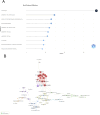Cluster analysis of hotspots and research trends of epirubicin-induced cardiotoxicity: a bibliometric study
- PMID: 40910006
- PMCID: PMC12405342
- DOI: 10.3389/fphar.2025.1616162
Cluster analysis of hotspots and research trends of epirubicin-induced cardiotoxicity: a bibliometric study
Abstract
Background: Epirubicin, a widely used anthracycline, effectively treats various cancers but poses a high risk of cardiotoxicity, leading to heart failure and myocardial dysfunction. This study conducts a cluster analysis to map global research trends in epirubicin-induced cardiotoxicity.
Methods: A literature search was conducted using the Web of Science Core Collection database. Bibliometric tools, including VOSviewer, CiteSpace, and R package "bibliometrix", were employed.
Results: A total of 673 studies were included in the analysis. Italy, China, and the United States led in publication volume. Unicancer was the most prolific institution. Key research was published in high-impact journals such as Journal of Clinical Oncology, Annals of Oncology, and European Journal of Cancer. P.F. Conte, J.W. Hopewell, and B. Salvadori were the most influential authors. Cluster analysis identified four research hotspots: mechanisms of cardiotoxicity, clinical applications of chemotherapy regimens, combination therapies and pharmacokinetics, formulation advancements and cardioprotective strategies. In addition, there is a clear cut-off among the strongest citation bursts, with the period from 2004-2013 primarily concentrated on disease treatment. From 2014 onwards, the last 10 years have focused on cardiotoxicity and the underlying mechanisms of cardiotoxicity.
Conclusion: This bibliometric study, based on cluster analysis, identified four research hotspots including mechanisms of cardiotoxicity, clinical applications of chemotherapy regimens, combination therapies and pharmacokinetics, formulation advancements and cardioprotective strategies. Future research directions should prioritize the development of AI-driven risk prediction models, integration of multi-omics biomarkers into clinical workflows, and establishment of international cardio-oncology consortiums to enhance personalized cardioprotective strategies and optimize patient outcomes.
Keywords: BIB; bibliomrtric; cardiotoxicity; cluster analysis; epirubicin.
Copyright © 2025 He, Wang, Luo and Wang.
Conflict of interest statement
The authors declare that the research was conducted in the absence of any commercial or financial relationships that could be construed as a potential conflict of interest.
Figures








References
LinkOut - more resources
Full Text Sources

